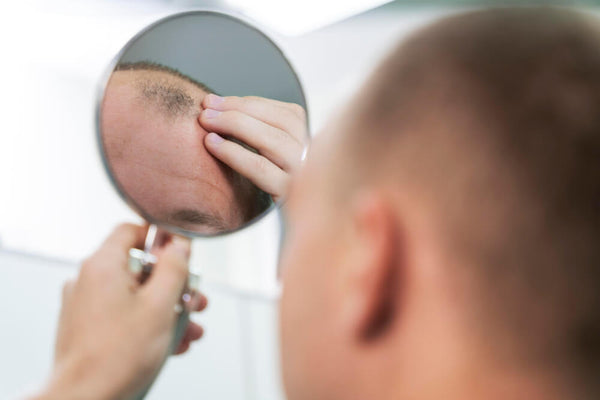Let me paint a picture you might recognize: You're getting ready for work, feeling halfway decent, until you notice those familiar white flakes on your black blouse. Again. Your scalp has been itching all morning, and when you gently scratch, your nails come back with that waxy, yellowish gunk. Worse yet—you're noticing more hair in your comb than usual.
If this is your reality, you're not just dealing with "dandruff." You're likely facing seborrheic dermatitis—a chronic inflammatory condition that doesn't just annoy you; it actively attacks your hair's ability to grow.
What's REALLY Happening Beneath the Flakes
Most people think dandruff is just dry skin. But seborrheic dermatitis is actually the opposite—it's an overreaction to yeast that naturally lives on your scalp. For most people, this yeast is harmless. But if your scalp is sensitive to it? Welcome to inflammation city.
Here's the damage it causes:
-
The Itch-Scratch Cycle of Destruction
That maddening itch isn't just a nuisance. Every time you scratch, you create micro-tears in your scalp that lead to more inflammation and even physically break hair shafts at their weakest point.
-
The Follicle Chokehold
All that scaling and buildup acts like concrete around your hair follicles. Imagine trying to grow a plant through a layer of bricks. The inflammation also swells the tissue around each follicle, literally choking it so healthy hair can't push through.
-
The Moisture Sabotage
Many of us respond to flakes by piling on heavy oils and butters. Bad move. You're essentially feeding the yeast that's causing the problem while creating more buildup.
Why Drugstore Shampoos Keep Failing You
That coal tar or zinc shampoo might give you a week of relief, but it always comes roaring back. Here's why:
-
They're too harsh for Black hair, stripping what little moisture we have
-
They treat the symptom (flakes) but not the root cause (inflammation)
-
They create a vicious cycle: flake → treat with drying shampoo → scalp overproduces oil → more yeast food → more flakes
I've had clients who've used the same medicated shampoo for years with zero long-term improvement. That's not treatment—that's dependency.
Our Approach: Calm the Fire, Don't Just Fan the Smoke
At Nina Ross Hair Therapy, we attack seborrheic dermatitis from every angle. We don't just want to manage your flare-ups; we want to put the fire out for good.
1. We Start with Proper Diagnosis
Is it really seborrheic dermatitis? Or is it psoriasis? Or a severe case of folliculitis? We use scalp scoping to see exactly what's happening at the follicular level so we're not just guessing.
2. We Soothe and Reset Your Scalp
We use medical-grade treatments that are strong enough to calm the inflammation but do not damage your textured hair in any way. Our treatments won’t strip your scalp but instead balance its microbiome and heal the skin barrier.
3. We Find Your Personal Triggers
This is the game-changer. Why is your immune system so reactive? We look at the whole picture that includes your gut health, hormonal imbalances, nutrient deficiencies and even the stress levels.
We use targeted lab testing to find these root causes so we can build a plan that actually lasts.
4. We Use Smart, Targeted Products
Our Nina Ross Dermatitis Shampoo is formulated differently. It manages flare-ups without destroying your hair's integrity. And internally, supplements like our Nina Black Currant Seed Oil Soft Gels provide powerful GLA to help your body cool systemic inflammation from the inside out.
5. We Revive Damaged Follicles
If the inflammation has already caused significant thinning, we use regenerative treatments like PRP and exosome therapy to wake up those dead follicles and encourage dense regrowth.
What You Can Start Doing Tonight
While we're big believers in comprehensive treatment, here are three things that can help immediately:
-
Wash More, Not Less: Weekly washing is non-negotiable for removing buildup.
-
Cool It Down: Use cool water when washing—heat inflames an already angry scalp.
-
Hands Off: Every time you want to scratch, massage instead with the pads of your fingers.
Ready to End the War With Your Scalp?
If you're tired of your hair itches, flakes and shedding, book your Hair Therapy Evaluation with us today for just $99. Let's give your scalp the peace it needs so your hair can finally thrive.














